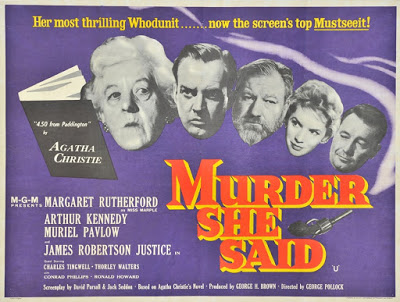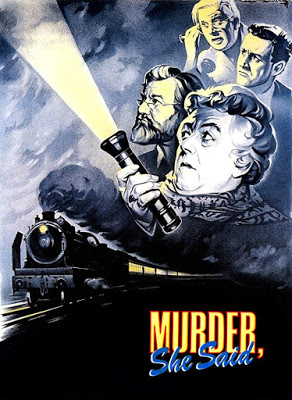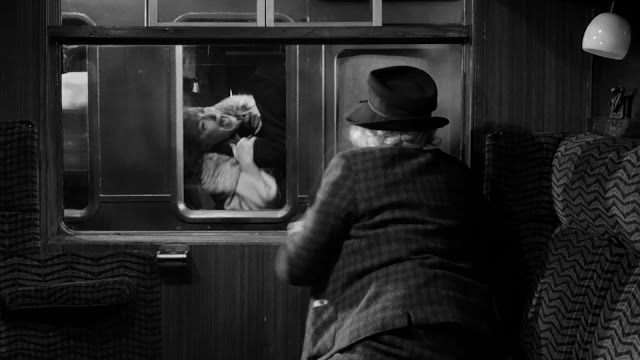Murder, She Said

Director: George Pollack
Year: 1961
Rating: 7.5
From the perspective of an Agatha Christie and Miss Marple fan of the novels,
the four Margaret Rutherford versions of the character are quite dreadful.
When Christie saw this one it is reported that she was horrified at what they
had done to her creation (though later she dedicated one of her books to
Rutherford). But from the perspective of a film fan these are quite entertaining
though silly films. The filmmakers turn Miss Marple into a slightly comical
character - more so if I recall as the series goes on - though with a spine
of stone. But clearly, the producers - MGM - didn't have a lot of respect
for Miss Marple. This is the only film of the four that is actually based
on a Miss Marple book (4:50 from Paddington) while the next two are based
on books of her other famous character, Hercule Poirot. These being Murder
Most Foul based on Mrs. McGinty's Dead and Murder at the Gallop being based
on After the Funeral. The final film - Murder Ahoy - is an original story
and again if I recollect the worst in the series.
It seems an odd choice as Miss Marple had lots of material to choose from
- 12 novels and a number of short stories - though Poirot had 33 novels. Christie
seemed ambivalent about Marple at first with Murder at the Vicarage being
published in 1930 and the next one - The Body in the Library - not till 12
years later. In the meantime she was churning out Poirot books consistently.
What may have driven this decision is that at least in the Marple books I
have read recently, she is a minor character time wise popping up occasionally
to solve the case in the end.
They change that of course in this film. Miss Marple is travelling on a
train when another train draws even with hers and she sees a woman being
strangled in the passing train. She reports it to the police but no body
is found and they put it down to an old lady's imagination. She gets her
friend Mr. Stringer to help her look for it and she comes to the conclusion
that it must have been taken and hidden in a large estate - in the book quite
coincidentally called Rutherford. So she does the natural thing and takes
a job as a maid and solves the case after a few more murders of course. Now
in the book it is a friend of Marple's who witnesses the murder and it is
another friend who goes to work undercover as the maid and reports back to
Miss Marple. So in the book Marple isn't in it much. But having Marple at
the manor gives the story more tension and more Marple of course. Which is
a good thing.
A few cast members of interest. One of the suspects is played by Ronald
Howard, son of Leslie, who played a famous sleuth on TV in the 1950s - that
of Sherlock Holmes. Mr. Stringer who is played by Stringer Davis and appears
in all four of the films was Rutherford's real life husband from 1945 until
Rutherford's death in 1972. She would only take a film if he had a part.
So in films like Runaway Bus you can spot him in the security office; in
Aunt Clara he is at the children's recital and in Innocents in Paris he is
the painter in the Louvre. It was by all accounts a loving marriage - both
marrying quite late in life. And perhaps most pleasing to me is the actress
who plays the other maid Mrs. Kidder played by Joan Hickson, who some 23
years later took on the role of Miss Marple in a series of TV shows and is
in my opinion the perfect Miss Marple. Christie would have loved her.
I watched a 60 minute documentary about Rutherford on YouTube sort of expecting
a cheerful recount of her life. Anything but. Her father murdered his father
and then spent the rest of his life in an asylum. Her mother hung herself
and Rutherford went to live with an aunt. During her life she suffered from
terrible bouts of depression that got worse as she got older and then not
too many years past her final Miss Marple in 1964 she began showing signs
of Alzheimer's and by 1967 she had to retire. She spent her last few years
being taken care of by her husband.






